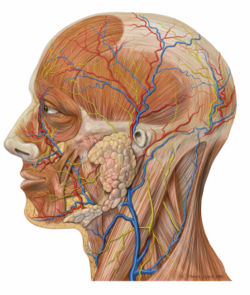- Occipital vein
-
Vein: Occipital vein Veins of the head and neck. (Occipial visible at left.) Lateral head anatomy detail Latin venae occipitales Gray's subject #167 646 Drains from scalp, occiput Drains to suboccipital venous plexus Artery occipital artery The occipital vein begins as a plexus at the posterior aspect of the scalp from the external occipital protuberance and superior nuchal line to the back part of the vertex of the skull.
From the plexus emerges a single vessel, which pierces the cranial attachment of the Trapezius and, dipping into the venous plexus of the suboccipital triangle, joins the deep cervical and vertebral veins.
Occasionally it follows the course of the occipital artery and ends in the internal jugular; in other instances, it joins the posterior auricular vein and through it opens into the external jugular.
The parietal emissary vein connects it with the superior sagittal sinus; and as it passes across the mastoid portion of the temporal bone, it receives the mastoid emissary vein which connects it with the transverse sinus.
The occipital diploic vein sometimes joins it.
Additional images
External links
- Occipital+vein at eMedicine Dictionary
This article was originally based on an entry from a public domain edition of Gray's Anatomy. As such, some of the information contained within it may be outdated.
Veins (emissary, jugular and others) of head and neck (drainage patterns can vary) (TA A12.3.04–06, GA 7.644) External jugular DirectInternal jugular Superficial cerebral veins: superior · superficial middle · inferior · inferior anastomotic (Labbé) · superior anastomotic (Trolard)
Deep cerebral veins: great · internal (basal, deep middle, superior thalamostriate)To COSTo CSTo IJVDirectBrachiocephalic occipital (occipital emissary) · suboccipital venous plexus
deep cervicalDirectCategories:- Cardiovascular system stubs
- Veins of the head and neck
Wikimedia Foundation. 2010.



